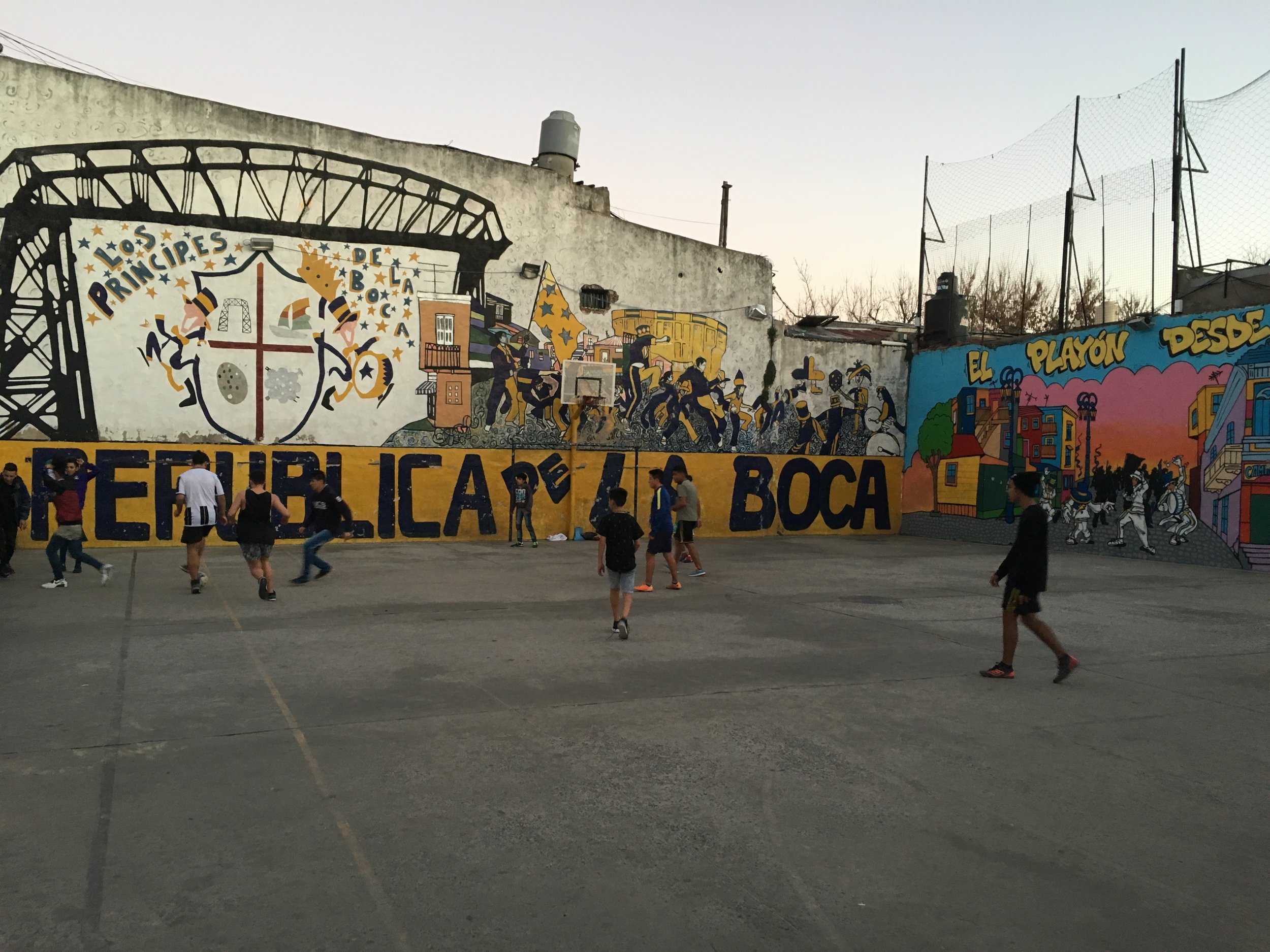LA PASIÓN BOQUENSE

Saturday 10th June 2017
Announcing itself in a celebration of brightly coloured buildings, the neighbourhood of La Boca boasts an identity of tradition and cultural diversity. Arriving on foot, you find yourself in the heart of the district with almost no warning or expectation. It's early Saturday afternoon, the street markets are bustling, and dancers exhibiting the famous Argentine Tango begin their matinee performances in the cafes and bars. The most striking thing to note upon first visit is the closeness of it all. Sidling between market stalls and up stairways into crowded shops, most of the tourist-orientated merchandise is packed into two or three colourful, picturesque streets.
In this sense, La Boca appears a typical tourist trap. Tango dancers with a wardrobe of costumes lure passers-by into posing for photos, plastic effigies of Pope Francis are wheeled out on street corners, and a man who looks vaguely like Diego Maradona bounces a ball in a fake Argentina strip. But it is only natural for the people of the area to monetise what has become such an identifiable corner of Buenos Aires. It has much to say for itself, but what brought this writer here was the stadium which peaks behind the aged rooftops - La Bombanera, the home of Boca Juniors.
Museo de la Pasión Boquense is the title of the tour and museum package sold at the stadium. This includes a guided tour around the ground and access to an exhibition of items and interactive media which tell the story of Club Atletico Boca Juniors. This writer embarked on this tour as a football fan, to get a better perspective of the club and to visit the stadium, but the experience provided a deeper understanding of the roots of the club and the significance it holds for the people who surround their lives with it.
For many in Argentina, football is treated as a way of life. This holds true for Boca fans, more so than many. It's the reason why their rivalry with city counterparts River Plate, el Superclásico, is considered one of the most intense and dangerous in the world. It's the reason their homes, businesses, and lampposts within the stadium vicinity are painted in blue and yellow club colours, and it's the reason the team are known and revered across world football today.
'In case you forget where you are, everything is painted as a reminder'
Ticket purchased, and with half an hour until the start of the guided stadium tour, there is time for a quick peruse of the museum beforehand. Drawing attention was a dome-shaped room with the appearance of a football, displaying 360° video inside. It documented the journey of a young local playing in the shadow of the stadium who grows up to play for the first team. All filmed within the immediate vicinity of the ground, with the viewer placed as the subject of the story, it communicates the passion and desire that the club affects on its community from a young age.
The other exhibit which piques the interest is a large model of the traditional homes which overlook the docks only a few streets away from the stadium. It was poignant that football has no visible mention or suggestion here. It stands as homage to the people, industry, and diversity which led to the formation of the club. Set against a dark night sky, small video projections lend life to the windows. Within them, Tango dancers, a family eating dinner, people drinking in a bar. A snapshot of life before Boca Juniors. With a large influx of European immigrants, the dockland area was one of many borrowed influences. Specifically, it was immigrants from Genoa who set about the foundation of a football club, hence the nickname 'Xeneizes' (Genoese), a nod to the club’s original founders.
Time arrived for the tour to begin. A large group numbering around 40 people is led from the museum through a concourse and into the lowest rows of seating in the 'flat' stand. The most recent notable upgrade, this stand was built in 1996 and consists mainly of VIP seating. In stark contrast to the other three surrounding sides of the stadium, which are cast in concrete and form a continuous wrap around the pitchside, it stands alone; a vertical tower block-like presence unique to La Bombanera. Despite its comparatively low profile and unorthodox structure, its proximity to the pitch enhances the atmosphere within the stadium. Venturing up to the top is a rather nausea-inducing experience for those with a dislike for heights.
The next stop was the terracing behind the goal; as the lowest tier
The tour is rounded off with a visit to the home dressing room, press area, and a celebratory room with statues of club legends, amongst them Martin Palermo, Juan Román Riquelme, and Diego Maradona. Funds for these were raised by fan contributions, and testament is paid to each one with an inscription of their name on the plinth on which the statue stands. The tour ended upon exiting this room, however no pressure was applied to for us leave the stadium. The opposing end of terracing left free to reign for photo opportunities, or sit and eat lunch with a view as we decided.
The path from the exit at La Bombanera leads back towards the throng of markets at the dock. Fresh from the Boca experience, this writer couldn't resist a replica retro shirt. The collared Nike design of season 1997/98, worn by Diego Maradona in his last season at the club, one of many on display with local vendors. On a concrete square, separated from the world by rusting blue and yellow fencing, young locals are involved in a heated kick about. Perhaps one of them may become a future Boca star...
Words and photos by Peter Burt.





